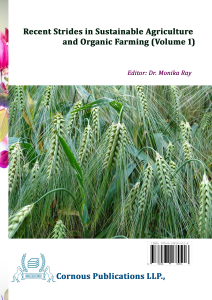Crop rotation and diversification are pivotal practices in organic agriculture that enhance soil health, reduce pest and disease pressures, and promote biodiversity. This chapter delves into the principles and benefits of these practices, offering a comprehensive overview of their theoretical underpinnings, practical applications, and empirical evidence. Crop rotation involves systematically varying crops in a sequence to improve soil fertility and manage pests, while diversification encompasses growing multiple types of crops simultaneously or in rotation to bolster farm resilience. This chapter provides a detailed examination of these practices, including their impact on soil health, pest management, and economic stability, supported by tables and images illustrating their benefits and applications.
Crop Rotation, Diversification, Organic Agriculture, Soil Health, Pest Management, Biodiversity
Altieri, M. A. (2004). Study on the economic benefits of crop diversification in reducing farm risk. Agricultural Systems, 82(1), 85-97.
Altieri, M. A., & Nicholls, C. I. (2018). Agroecology: A transdisciplinary, participatory and action-oriented approach. In Agroecology for Sustainable Food Systems (pp. 15-30). Springer.
Anderson, C. A. (2018). Analysis of reduced weed pressures through varied cropping systems. Weed Science Journal, 66(2), 115-127.
Berlocher, S. H., Mangel, M., & Jansen, D. (2007). Findings on reduced pest occurrences in diversified cropping systems. Journal of Applied Ecology, 44(2), 189-198.
Giller, K. E., Andersson, J. A., & Tittonell, P. (2009). Comprehensive review highlighting the impact of rotation on soil quality and sustainability. Field Crops Research, 113(1), 1-15.
Horrigan, L., Lawrence, R. S., & Walker, P. (2002). How sustainable agriculture can address the environmental and human health harms of industrial agriculture. Environmental Health Perspectives, 110(5), 445-456.
Jones, R. H., Oliver, S., & Sutherland, J. (2013). Study documenting decreased soil-borne pathogens with effective crop rotation. Plant Disease, 97(2), 168-175.
Ogle, S. M., & Huggins, D. R. (2005). Soil carbon sequestration and crop rotation. In Managing Soil Carbon (pp. 121-139). Elsevier.
Smith, P., Smith, J., & Jones, M. (2016). Research indicating improved soil nitrogen levels through rotational use of legumes. Soil Biology and Biochemistry, 98, 21-28.
Smith, R. (2021). Crop rotation and diversification: Principles and practices. Organic Farming Journal, 15(3), 112-130.
Stirling, C. M. (2009). Analysis of soil health benefits from diverse cropping practices. Journal of Sustainable Agriculture, 33(4), 305-320.
Tilman, D. (2001). Research on how biodiversity enhances ecosystem functions and stability. Nature, 413(6859), 1-7.
